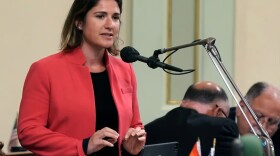A developer who faced public outcry for its plans to build a downtown San Diego high-rise with a separate door and fewer amenities for low-income affordable housing residents has changed the design to create a common entrance and common lobby.
The design change came after Civic San Diego, the city’s nonprofit redevelopment agency, rejected the original design for the project proposed for 11th Avenue and A Street by Pinnacle International. The company had initially threatened to sue over the rejected plans.
RELATED: Controversy Over Who Gets Access To Amenities Surrounds Downtown High-Rise Project
Pinnacle wants to build three buildings with market-rate apartments and a fourth with 58 affordable apartments for low-income renters. The original plan was for the affordable building to be connected to one of the market-rate towers, but the low-income residents would enter their building through a separate entrance.
Community advocates here and elsewhere have referred to such entrances as "poor doors."
The redesigned project would still have a separate building for low-income residents connected to one of the towers, but would have a common entrance, lobby, reception area and mailroom. However, low-income residents would still not be able to use the pool, spa, or rooftop deck available to market-rate residents.
The new design also includes a common area on the fourth floor open to all residents that could be used as a lounge, gym, or programming area for classes such as financial literacy, said David Dick, Pinnacle's legal counsel.
"We've tried to make it appear as a single project with a single entrance and a single identity," he said. Dick added that he believes the new design addresses previous criticisms and creates "a unified common community that everyone there will be able to enjoy."
Rents in Pinnacle’s three towers with market-rate apartments would likely be around $2,700 for two bedrooms, while units in the building with affordable housing would rent for about half that. Under current local rules, a developer can build more units than zoning regulations allow as long as the affordable building is within a mile of the market-rate apartments.
The Civic San Diego board voted 6-1 for the redesign, with the dissenting vote cast by Robert Robinson. He questioned why the new design had separate loading docks for affordable housing residents and market-rate residents.
Doug Hicks with the San Diego Union Carpenters Local 619 also criticized the project's redesign. The union has been a long-time critic of the developer.
"Well, ladies and gentlemen, I believe we're looking at a miracle," Hicks said. "When we first talked to Pinnacle about this project, they said this could not be done, they said we can not join these buildings, we cannot share amenities, it simply couldn't be done. Miraculously, when they heard the word 'no,' they found a way."
Hicks said the redesign is a step in the right direction. But he questioned why the fourth-floor hallway was not connected between the affordable housing side and the market rate side, so that "a kid who lives in one building and their friend lives in the other, they have to go down to the lobby."
Last week, Assemblywoman Lorena Gonzalez (D-San Diego) proposed a bill that would ban separate doors and amenities for such projects in California.
"How does a single mom explain to her child that she is living in the same building as somebody from school but she can't utilize the pool or can't come through the front door," Gonzalez said. "That's sick."
Gonzalez said on Wednesday that she still doesn't like the project.
"Segregating residents of an inclusionary housing development by income is wrong no matter how you do it," she said.






